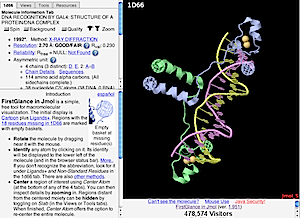FirstGlance in Jmol: Difference between revisions
Eric Martz (talk | contribs) No edit summary |
Eric Martz (talk | contribs) No edit summary |
||
| Line 4: | Line 4: | ||
FirstGlance in Jmol ([http://firstglance.jmol.org firstglance.jmol.org]) is a free, open-source, macromolecular visualization software package that operates on-line in a web browser. It uses the free open-source [[Jmol|Jmol java applet]], as does Proteopedia. It works in the most popular web browsers, and MS Windows, Apple Mac OS X, and linux. It operates from menus and forms -- no familiarity with the Jmol command scripting language is required. Tooltips are used extensively, and explanatory help, with color keys, appears automatically for each view. | FirstGlance in Jmol ([http://firstglance.jmol.org firstglance.jmol.org]) is a free, open-source, macromolecular visualization software package that operates on-line in a web browser. It uses the free open-source [[Jmol|Jmol java applet]], as does Proteopedia. It works in the most popular web browsers, and MS Windows, Apple Mac OS X, and linux. It operates from menus and forms -- no familiarity with the Jmol command scripting language is required. Tooltips are used extensively, and explanatory help, with color keys, appears automatically for each view. | ||
''3D View'' or "3D" links to FirstGlance in Jmol have been available in every article reporting a new structure in [http://www.nature.com/nsmb ''Nature Structural and Molecular Biology''] beginning in February, 2006, and in [http://www.nature.com/nature ''Nature''] from November, 2007. It is also offered as a visualization option by numerous structural bioinformatics servers and databases, including '''Proteopedia''', [[Conservation, Evolutionary|ConSurf]], the [[Protein Data Bank]], [http://opm.phar.umich.edu/ Orientations of Proteins in Membranes], and [http://firstglance.jmol.org/adoption.htm others]. | ''3D View'' or "3D" links to FirstGlance in Jmol have been available in every article reporting a new structure in [http://www.nature.com/nsmb ''Nature Structural and Molecular Biology''] beginning in February, 2006, and in [http://www.nature.com/nature ''Nature''] from November, 2007. It is also offered as a visualization option by other journals and numerous structural bioinformatics servers and databases, including the journal ''[http://proteinscience.org/ Protein Science]'', '''Proteopedia''', [[Conservation, Evolutionary|ConSurf]], the [[Protein Data Bank]], [http://opm.phar.umich.edu/ Orientations of Proteins in Membranes], and [http://firstglance.jmol.org/adoption.htm others]. | ||
In order to be as easy as possible to use, FirstGlance in Jmol does not provide tools to customize the molecular view, but rather offers a series of "canned" views that reveal the major structural features of the molecule, such as composition (protein, DNA, RNA, ligand and solvent) secondary structure, amino and carboxy termini, hydrophobic and polar surfaces, surface charges, salt bridges and cation-pi interactions. Any moiety can be hidden by clicking on it in ''Hide'' mode. Any residue or sequence number can be found/located in the ''Find'' dialog. | In order to be as easy as possible to use, FirstGlance in Jmol does not provide tools to customize the molecular view, but rather offers a series of "canned" views that reveal the major structural features of the molecule, such as composition (protein, DNA, RNA, ligand and solvent) secondary structure, amino and carboxy termini, hydrophobic and polar surfaces, surface charges, salt bridges and cation-pi interactions. Any moiety can be hidden by clicking on it in ''Hide'' mode. Any residue or sequence number can be found/located in the ''Find'' dialog. | ||
Revision as of 02:50, 26 December 2013

Every molecule in Proteopedia can be explored in FirstGlance in Jmol, using the link beneath the molecule (on pages titled with a PDB code).
FirstGlance in Jmol (firstglance.jmol.org) is a free, open-source, macromolecular visualization software package that operates on-line in a web browser. It uses the free open-source Jmol java applet, as does Proteopedia. It works in the most popular web browsers, and MS Windows, Apple Mac OS X, and linux. It operates from menus and forms -- no familiarity with the Jmol command scripting language is required. Tooltips are used extensively, and explanatory help, with color keys, appears automatically for each view.
3D View or "3D" links to FirstGlance in Jmol have been available in every article reporting a new structure in Nature Structural and Molecular Biology beginning in February, 2006, and in Nature from November, 2007. It is also offered as a visualization option by other journals and numerous structural bioinformatics servers and databases, including the journal Protein Science, Proteopedia, ConSurf, the Protein Data Bank, Orientations of Proteins in Membranes, and others.
In order to be as easy as possible to use, FirstGlance in Jmol does not provide tools to customize the molecular view, but rather offers a series of "canned" views that reveal the major structural features of the molecule, such as composition (protein, DNA, RNA, ligand and solvent) secondary structure, amino and carboxy termini, hydrophobic and polar surfaces, surface charges, salt bridges and cation-pi interactions. Any moiety can be hidden by clicking on it in Hide mode. Any residue or sequence number can be found/located in the Find dialog.
Non-covalent interactions (hydrogen bonds, salt bridges, hydrophobic interactions) with any designated target moiety are displayed automatically in a powerful Contacts dialog in FirstGlance in Jmol. The target moiety (a chain, a range of residues in a chain, a residue or group, or a single atom) is selected beforehand by clicking on it.
Any molecular view obtained in FirstGlance in Jmol can become a scene attached to a green link in Proteopedia: please see Help:Copying FirstGlance Scenes into Proteopedia.
See AlsoSee Also
- Help:Copying FirstGlance Scenes into Proteopedia.
- What is FirstGlance in Jmol? (Includes comparisons with other software packages.)
- All About FirstGlance in Jmol.
- Jmol
- Molecular modeling and visualization software
- Protein Explorer.